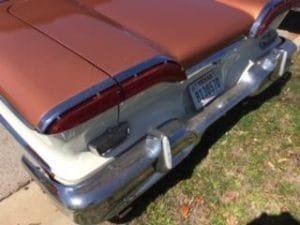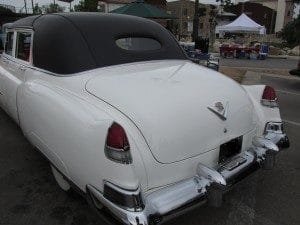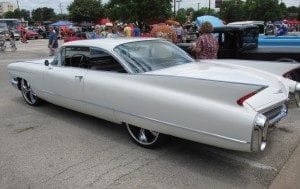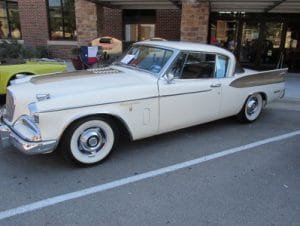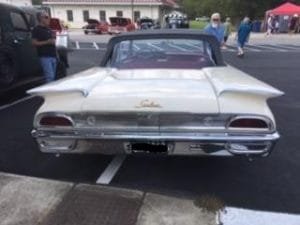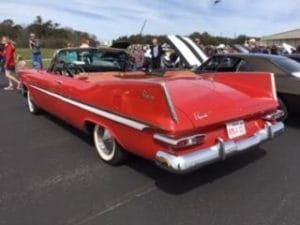Many say that if you take a look at the P-38 Lightning airplane of World War Two you’re looking at the plane that inspired the design of the 1948 Cadillac overseen by General Motors design chief Harley Earl. It was this out of the ordinary auto design that was largely responsible for the auto fin craze of the 1950’s. Harley Earl was an aircraft buff and his inspiration for the 1948 Cadillac came directly from the dual tailfins of the P-38 Lightning he first viewed in 1941. The P-38 made it’s way into automobile designing seven years later in 1948.

When World War Two ended and automakers turned to producing cars rather than war materials, the 1950’s, the decade when American manufacturers returned to consumer spending was not far away.
After the Second World War General Motors recognized two elements that helped sell cars. These were the vehicles design itself and the automatic transmission. You might think engineering should have been at the top but, while engineering is a prime factor, GM assumed that people wouldn’t buy what couldn’t be seen. You could see the design, see the chrome and enjoy the comfort afforded by an automatic transmission but solid engineering was under the hood and under the body and essentially out of sight.

Another factor that inspired radical design changes compared to prewar models was the war itself. Stylists were hampered by the war effort.
The automobile industry was focused upon building war machinery and stylists took a back seat. When the war ended stylists and designers were able to unleash their pent up energy which did take a few years to materialize and showed up in most auto brands during the 1948 model year.
Another offshoot of faster design changes were bigger profits. Change a few things like the size of the fins and a car buyer might think his car is outdated perhaps just a year or two after he purchased it. All of the major car brands were doing this but new, and in some cases radical designs, caught the eye of the 1950’s auto buyer that he didn’t mind the rapid design changes.
While automobile fins of the 1950’s were what much of the decades car designs featured, there were other new automobile military terms used in 1950’s styling. These included portholes (Buick), gunsight (Buick hood ornament) and bomb-sight (Chevrolet).
Below is a list of some of the noteworthy automobile tail fin designs of the 1950’s.
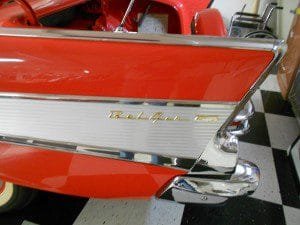
The 1957 Chevrolet Bel Air
The 1957 Chevy was more sporty and more modern than it’s predecessors. This is one of the most recognized automobiles ever produced. Chevrolet wanted to roll out an entirely new Bel Air model for 1957 but production concerns kept the basic design one more year. The general car body was the same as the 1955 and 1956 models.
That wasn’t to say their weren’t styling changes. There were several. The rear fender was shaped into wide flat tail fins. The now famous ’57 Chevy tail fins were designed to duplicate the wide look in the rear. The Bel Air had chrome moldings topping the rear fins. Also, the fuel cap door was hidden in the left rear chrome fin trim. The 57 Chevy fins have stayed with us throughout the decades with some of their styling being built into motorcycles and boats.
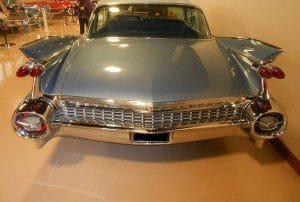
The 1959 Cadillac
It’s been said by some that the 1959 Cadillac was an automobile representing excess in design. Because of the massive tail fins and it’s rocket/airplane type of body style some have said that the 1959 Cadillac was way over the top and therefore don’t give credit to the car itself.
When you looked at the car’s appearance you either liked it or didn’t.The entire jet like appearance of the car was one in which people either liked it or didn’t. There wasn’t a lot of in between. In reality, tail fins on cars seemed to be more prevalent as each year of the 1950’s passed. The very size of the fins on the 1959 Cadillac may have been an omen that their days were numbered.
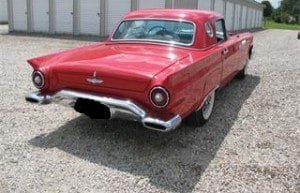
The 1957 Thunderbird
Unlike today, there was an era that the Chevrolet Corvette and the Ford Thunderbird took some big risks with design changes. The year 1957 was one of them. The 1957 Thunderbird underwent a redesign including a prominent bumper/grille and a longer rear deck sporting modest blade like tail fins. The fins were a lot different than other cars of the late 50’s and could be described as understated. This was also the last year of the Thunderbird two seater. Ford wanted to position the T-Bird as a luxury car and therefore added a back seat.
The 1957 Ford Thunderbird was part of the first generation. The tail fins actually became a bit more prominent. The 1961 Thunderbird which was the first of the third generation models came with taillights and fins that made the car look somewhat like a jet or rocket ship.
Two books that we believe you’ll want to consider on the subject of car styling of the 1950’s are listed on the links below…
My Dad Had That Car : A Nostalgic Look At The American Automobile, 1920-1990
Auto Museum Online earns a commission on these sales at no cost to you.
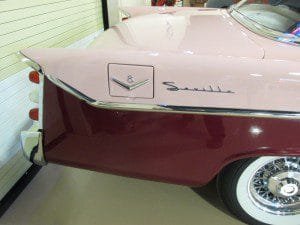
The 1956 DeSoto Firedome
De Soto cars were produced by Chrysler and the De Soto line was utilized to fill in the gap between the Chrysler and Dodge brands. This all occurred during the rapid mergers of the 1920’s.
The tail fins on the 1956 DeSoto were styled by the Chrysler design team headed by the legendary Virgil Exner. The 1956 DeSoto styleing was another step in Chrysler’s Forward Look design strategy.
Along with the new tail fins in 1956 the DeSoto Firedome tail lights gave the automobile a rocket like rear end. Although this was an all new design for the DeSoto by Exner, the tail fins were described by some as huge and by others as modest. The 1957 DeSotos would go on to have even larger fins. Nevertheless, these tail fins certainly gave the 56 DeSoto a faster look than the rounded rear end look of the 1955 model.
See our articles on the links below…
Sample Classic Auto Serial Number Decoding
Serial Numbers and VIN’s…What Do They Tell Us?

The 1958 Chevrolet Impala
Just one year after the introduction of the tail fin iconic 1957 Chevy Bel Air, General Motors comes out with an entirely new design with it’s 58 Chevy Impala. The 1958 Impala had a Harley Earl design. In actuality, Chevrolet changed the names for its completely redesigned 1958 models. This was also the first year that Chevrolet offered an Impala model. The very popular Bel Air remained at the top of the ladder.
The rear of the vehicle had deeply sculpted fenders and triple tail lights. The tail of the car actually looks to have horizontal fins rather than the sharp vertical fins from 1957. In 1959 the car buying public would see mush more enhanced tail fins. While is was an all new design, it lasted for only one year in spite of the fact that sales were not bad. More design changes during the late 1950’s generally meant more car sales.
(Article copyright 2019 AutoMuseumOnline)
